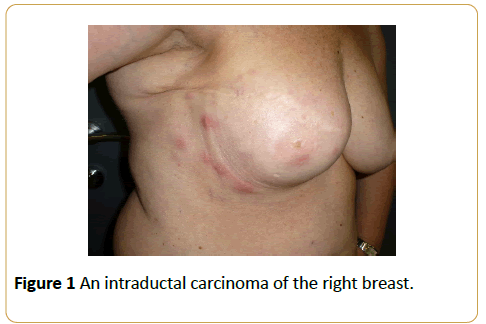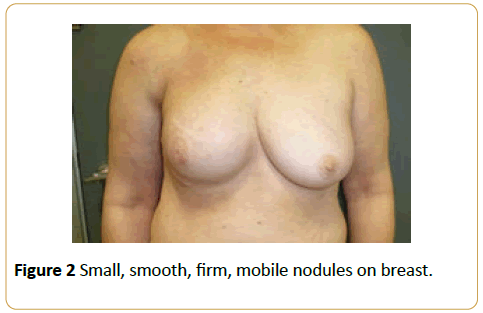Carmen Herrero-Vicent1*, Garcia-Agudo S2, González-Álvarez A2, Fernández-Landazuri S3, Smith S1, Ferrer AI1 and Ruiz A4
1Department of Medical Oncology, Hospital Obispo Polanco, Spain
2Depatment of Pharmacy, Hospital Obispo Polanco, Spain
3Department of Clinical Analysis, Hospital Obispo Polanco, Spain
4Department of Medical Oncology, Valencian Institute of Oncology, Spain
*Corresponding Author:
Carmen Herrero
Department of Medical Oncology
Hospital Obispo Polanco, Spain
Tel: +34 978 65 40 00
E-mail: carmendcn@hotmail.com
Received date: May 25, 2017; Accepted date: August 24, 2017; Published date: August 31, 2017
Citation: Vicent CH, Agudo SG, Álvarez AG, Landazuri SF, Smith S, et al. (2017) Breast Implant-Associated Anaplastic Large-Cell Lymphoma: A Case Report. Arch Can Res Vol.5:No.3:152. doi:10.21767/2254-6081.1000152
Keywords
Skin ulceration; Cell lymphoma; Intraductal carcinoma, Breast cancer
Introduction
Anaplastic large cell lymphoma is a very rare T-cell lymphoma and it has been found to be associated with breast implants. It is important to focus on awareness of breast physicians to improve early detection rates.
Case Presentation
A 52-year-old female was diagnosed with an intraductal carcinoma of the right breast pT2N0 after a mastectomy with breast reconstruction using an implant in July 2000. She was treated with six cycles of adjuvant chemotherapy (Cyplophosphamide, Doxorrubicine, 5-Fluorouracil) and Tamoxifen for 5 years.
The patient remained disease-free for 13 years until a single, newly formed 6 cm supra-clavicle node was discovered which was accessible for biopsy. Histological examination of the specimen described a grade 3 triple negative intraductal carcinoma of breast cancer. At this point, the patient had received treatment with Paclitaxel-Bevacizumab, but after 3 cycles, the patient presented progression of her disease.
Therefore, the treatment was changed to a combination of Capecitabine and radiation therapy of the chest-wall and supraclavicular fosse, without any response.
One month later, the patient developed sudden, uncomfortable swelling in her right (reconstructed) breast and small, smooth, firm, mobile nodules with mastitis-like symptoms and without skin ulceration in Figures 1 and 2. Breast implant-associated anaplasic large-cell lymphoma (ALCL) ALK is negative.

Figure 1: An intraductal carcinoma of the right breast.

Figure 2: Small, smooth, firm, mobile nodules on breast.
Discussion
The entity of breast implant-associated ALCL was first described by Keech and Creech [1] in 1997, and currently at least 63 cases have been described in the literature [2]. A study in the Netherlands estimated that there is, on average, 1 out 500,000 women with prothesis per year [3].
The most common clinical presentation is unilateral breast swelling because of the periprothesic fluid, which presents 1 year after surgery or as a palpable cutaneous mass or solid mass attached to the implant capsule [4].
ALCL is divided into two groups, the first being cutaneous ALCL, and the second being systemic nodal ALCL, which is subdivided into ALK-positive or ALK-negative disease. Typically, the ALK-positive ALCL is correlated with younger age groups and has a more favorable clinical outcome than ALK-negative ALCL. Breast implant-associated ALCL is commonly ALKnegative, despite this, the prognosis is generally favorable.
20455
References
- Aladily TN, Medeiros LJ, Amin MB, Haideri N, Ye D, et al. (2012) Anaplastic large cell lymphoma associated with breast implants: a report of 13 cases. Am J Surg Pathol 36: 1000-1008.
- Thompson PA, Lade S, Webster H, Ryan G, Prince HM (2010) Effusion-associated anaplastic large cell lymphoma of the breast: time for it to be defined as a distinct clinico-pathological entity. Haematologica 95: 1977-1979.
- Popplewell L, Thomas S, Huang Q, Chang K, Forman S (2012) Primary anaplastic large-cell lymphoma associated with breast implants. Leuk Lymphoma 52: 1481-1487.
- De Jong D, Vasmel WL, De Boer JP, Verhave G, Barbé E (2008) Anaplastic large-cell lymphoma in women with breast implants. JAMA 300: 2030-2035.







